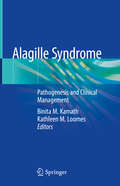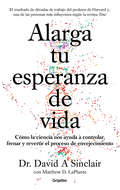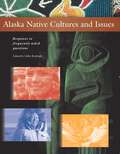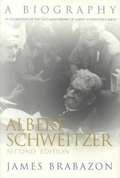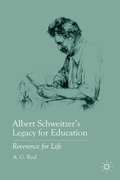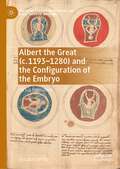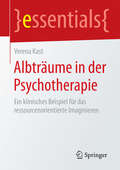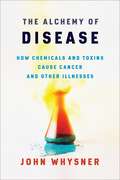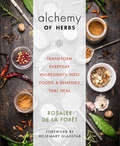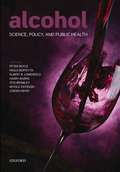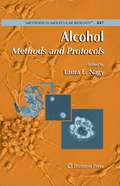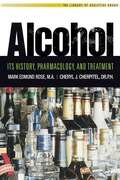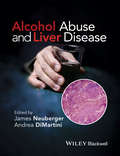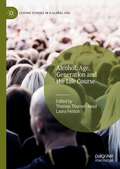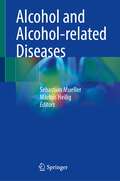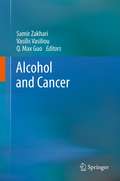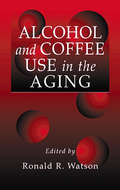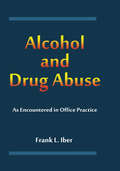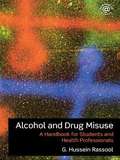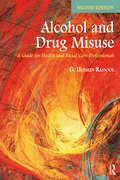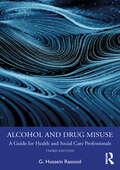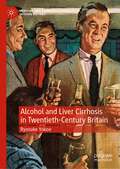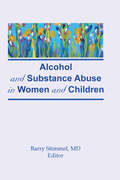- Table View
- List View
Alagille Syndrome: Pathogenesis And Clinical Management
by Binita M. Kamath Kathleen M. LoomesThis text provides a concise yet comprehensive overview of Alagille syndrome. The book reviews the pathophysiology and genetics of the disorder, discusses recent molecular advances and its impact on diagnostics, and describes management challenges and strategies. The text also touches upon future treatment options.Written by experts in the field, Alagille Syndrome: Pathogenesis and Clinical Management is a valuable resource for physicians and researchers dealing with this disorder, one that will help guide patient management and stimulate investigative efforts.
Alarga tu esperanza de vida: Cómo la ciencia nos ayuda a controlar, frenar y revertir el proceso de envejecimiento
by David A. Sinclair Matthew D. LaPlante¿Y si envejecer fuera una enfermedad y fuese tratable como tal? Un aclamado científico de la facultad de Medicina de Harvard y una de las personas más influyentes según la revista Time. Que envejecer es inevitable es una verdad aparentemente innegable. pero, ¿qué pasaría si todo lo que se nos ha dicho hasta ahora sobre el envejecimiento resultase incierto?, ¿qué sucedería si pudiéramos elegir nuestra esperanza de vida? En este libro innovador y asombroso, el Dr. David Sinclair, autoridad mundial y líder en genética y longevidad, revela una nueva y audaz teoría. Como él explica, el envejecimiento es una enfermedad y es una enfermedad tratable. Experimentos recientes en la reprogramación genética sugieren que, en un futuro cercano, no solo podremos sentirnos más jóvenes, sino serlo. Mediante estas páginas, el Dr. Sinclair nos invita al proceso de descubrimiento científico y revela algunas tecnologías emergentes y algunos cambios simples en el estilo de vida que nos ayudarán a sentirnos más jóvenes y a estar más saludables por más tiempo como el ayuno intermitente, la exposición al frío, hacer ejercicio con la intensidad adecuada y comer menos carne. Alarga tu esperanza de vida cambiará para siempre nuestra idea sobre por qué envejecemos y qué podemos hacer al respecto.
Alaska Native Cultures and Issues: Responses to Frequently Asked Questions
by Libby RoderickMaking up more than ten percent of Alaska's population, Native Alaskans are the state's largest minority group. Yet most non-Native Alaskans know surprisingly little about the histories and cultures of their indigenous neighbors, or about the important issues they face. This concise book compiles frequently asked questions and provides informative and accessible responses that shed light on some common misconceptions. With responses composed by scholars within the represented communities and reviewed by a panel of experts, this easy-to-read compendium aims to facilitate a deeper exploration and richer discussion of the complex and compelling issues that are part of Alaska Native life today.
Albert Schweitzer: A Biography
by James BrabazonJames Brabazon updates his critically acclaimed biography of humanitarian Albert Schweitzer to include a wealth of recently discovered documents, including the letters between Schweitzer and Helene Bresslau written during the ten years before their marriage. Brabazon's research has also included recently released documents from the State Department regarding Schweitzer's battle with the United States Atomic Energy Commission to halt H-bomb tests.
Albert Schweitzer’s Legacy for Education
by A. G. RudThis is the first book devoted to the study of the thought of Albert Schweitzer as it relates to educational theory and practice. Rud argues that Schweitzer's life and work offer inspiration and timely insights for both educational thought and practice in our new century.
Albert the Great: Virtus Formativa (Palgrave Studies in Medieval and Early Modern Medicine)
by Amalia CerritoThis book provides the first comprehensive treatment of Albert the Great’s (c. 1193–1280) notion of virtus formativa, a shaping force responsible for crucial dynamics in the formation of living beings. Crossing the boundaries between theology and philosophy, the notion of virtus formativa, or formative power, was central in explaining genetic inheritance and the configuration of the embryo. By adopting an interdisciplinary approach, this book reconstructs how Albert the Great, motivated by theological open issues, reorganised the natural-philosophical and medical theories on embryonic development, creatively drawing upon Greek, Patristic, and Arabic sources. A valuable contribution to research, this book offers essential insights for those studying the history of embryology, medicine, and science in the medieval and renaissance periods.
Alberta: A Health System Profile (Provincial and Territorial Health System Profiles)
by John Church Neale SmithAlberta: A Health System Profile provides the first detailed description of Alberta’s health care system and the underpinning political and social forces that have shaped it. Drawing on significant wealth from government revenues generated through the energy sector, Alberta has been able to develop an extensive public health and health care infrastructure. Alberta has used its financial resources to attract health professionals by offering the highest levels of financial compensation in Canada. However, although it spends more per capita than other Canadian jurisdictions, Alberta’s health care system costs and health outcomes are mediocre compared to those of many other Canadian jurisdictions. This unexpected outcome is the consequence of the unique interplay of economic and political forces within Alberta’s political economy. Through an examination of Alberta’s political and economic history, and using research on the structures and services provided, Alberta: A Health Systems Profile provides a detailed description of the programs and services that constitute Alberta’s health care system.
Albträume in der Psychotherapie: Ein klinisches Beispiel für das ressourcenorientierte Imaginieren (essentials)
by Verena KastVerena Kast schildert, wie im Rahmen der Psychotherapie Imagination im Zusammenhang mit Albträumen als Emotionsregulierung wirken und kreative Fantasien wecken kann. Das Arbeiten mit der Imagination ist hierbei durchsetzt von therapeutischen Interventionen, mit dem Blick darauf, Imaginationen der Angst in Imaginationen überzuführen, die Zukunft ermöglichen, kreativ und oft mit Ansätzen von Freude verbunden sind. Ein klinisches Beispiel zeigt, wie eine Analytikerin mit den Albträumen der Analysandin auch die kreativen Aspekte der Imagination bearbeitet und so einen Zugang zu ihrer Ressource herstellt.
The Alchemy of Disease: How Chemicals and Toxins Cause Cancer and Other Illnesses
by John WhysnerSince the dawn of the industrial age, we have unleashed a bewildering number of potentially harmful chemicals. But out of this vast array, how do we identify the actual threats? What does it take to prove that a certain chemical causes cancer? How do we translate academic knowledge of the toxic effects of particular substances into understanding real-world health consequences? The science that answers these questions is toxicology.In The Alchemy of Disease, John Whysner offers an accessible and compelling history of toxicology and its key findings. He details the experiments and discoveries that revealed the causal connections between chemical exposures and diseases. Balancing clear accounts of groundbreaking science with human drama and public-policy relevance, Whysner describes key moments in the development of toxicology and their thorny social and political implications. The book features discussions of toxicological problems past and present, including DDT, cigarettes and other carcinogens, lead poisoning, fossil fuels, chemical warfare, pharmaceuticals—including opioids—and the efficacy of animal testing. Offering valuable insight into the science and politics of crucial public-health concerns, The Alchemy of Disease shows that toxicology’s task—pinpointing the chemical cause of an illness—is as compelling as any detective story.
Alchemy of Herbs: Transform Everyday Ingredients into Foods and Remedies That Heal
by Rosalee de la ForêtDid you know there’s a powerful herbal medicine chest in your kitchen?Imagine being prepared for that next cold, scrape, headache, digestive issue, stressful day, or sleepless night with simple ingredients from your cupboard. Instead of pills, reach for:Cinnamon Tea to soothe your throat . . . Garlic Hummus to support your immune system . . . Ginger Lemon Tea for cold and flu symptoms . . . Cayenne Salve to relieve sore muscles . . . Cardamom Chocolate Mousse Cake for heart health . . . A glass of Spiced Cold Brew Coffee as a powerful antioxidant . . .Alchemy of Herbs will show you how to transform common ingredients into foods and remedies that heal. What were once everyday flavorings will become your personal kitchen apothecary. While using herbs can often seem complicated or costly, this book offers a way to learn that’s as simple and inexpensive as cooking dinner.With the guidance of herbalist Rosalee de la Forêt, you’ll understand how to match the properties of each plant to your own unique needs, for a truly personalized approach to health for you and your family.In addition to offering dozens of inspiring recipes, Rosalee examines the history and modern-day use of 29 popular herbs, supporting their healing properties with both scientific studies and in-depth research into herbal energetics.Grow your knowledge of healing herbs and spices, and start using nature’s pharmacy to feed, heal, and nurture your whole family!
Alcohol: Science, Policy and Public Health
by Peter Boyle Paolo Boffetta Albert B. Lowenfels Harry Burns Otis Brawley Witold Zatonski Jürgen RehmAlcohol has always been an issue in public health but it is currently assuming increasing importance as a cause of disease and premature death worldwide. Alcohol: Science, Policy, and Public Health provides an interdisciplinary source of information that links together, the usually separate fields of, science, policy, and public health. This comprehensive volume highlights the importance of bringing scientific knowledge to bear in order to strengthen and develop alcohol public policy. The book looks at the historical evolution of alcohol consumption in society, key early studies of alcohol and disease, and the cultural and social aspects of alcohol consumption. It then goes on to cover the chemistry and biology of alcohol, patterns of consumption, gender and age-related issues, alcohol and injury, alcohol and cancer and non-malignant disease, and various current therapeutic aspects. The book concludes with a section on alcohol policy, looking at issues of poverty, the availability of alcohol and alcohol control measures. This major reference, written by international leaders in the fields of alcoholism and alcohol policy, provides a comprehensive study of one of the foremost health problems in the world, and represents the highest standards of research within the field. It will be valuable to physicians and health professionals involved with patients with alcohol-related problems, scientists, public health specialists, health policy specialists, researchers and legislators as well as students of public health.
Alcohol: Methods and Protocols (Methods in Molecular Biology #447)
by Laura E. NagyThis book examines the pleiotropic effects of ethanol in animal and cell culture models through a collection of detailed procedures written by experts in the field. Sections present clearly defined models of ethanol exposure, recent advances in the development of specific methodologies to mimic the impact of ethanol metabolism in cultured cells, and methodologies to investigate a variety of cells and tissues that are known to be disrupted by ethanol, amongst other topics.
Alcohol: It's History, Pharmacology and Treatment
by Mark Edmund Rose Cheryle J. CherpitalThe definitive guide to the effect of alcohol on people, families, communities, and society, written by two of America's leading experts on alcoholism and its impact.Throughout history, and across cultures, alcohol has affected the fabric of society through abuse and addiction, contributed to violence and accidents, and caused injuries and health issues. In Alcohol: Its History, Pharmacology, and Treatment, part of Hazelden's Library of Addictive Drugs Series, Cheryl Cherpitel, DrPH, and Mark Rose, MA, examine the nature and extent of alcohol use in the United States, current treatment models and demographics, and the biology of alcohol, addiction, and treatment.In separating fact from fiction, Cherpitel and Rose give context for understanding the alcohol problem by tracing its history and different uses over time, then offer an in-depth look atthe latest scientific findings on alcohol's effects on individualsthe myths and realities of alcohol's impact on the mindthe societal impacts of alcohol abuse as a factor in violence and accidentsthe pharmacology of pharmaceutical treatments for alcoholismthe history of treatment and current therapeutic treatment modelsThoroughly researched and highly readable, Alcohol offers a comprehensive understanding of medical, social, and political issues concerning this legal, yet potentially dangerous, drug.
Alcohol Abuse and Liver Disease
by James Neuberger Andrea DimartiniFor people with alcohol excess and liver disease, successful management must be two-fold with management of both their psychological/physical addiction to alcohol and their liver disease. Alcohol Abuse and liver disease, with its joint focus on hepatology and psychiatry, provides both hepatologists and psychiatrists of all levels with a practical, concise and didactic guide to the investigation and clinical management of those with alcohol-related problems. Edited by a practicing hepatologist in the UK and a practising specialist in psychiatry/substance abuse in the US, it covers areas such as: * Risk factors for alcoholic liver disease * Interaction of alcohol with other co-morbidities * Clinical assessment of alcohol intake * Detoxification and management of withdrawal * Psychotherapeutic and pharmaceutical interventions * Treatment of liver disease Key points, management diagrams and high-quality images are all be supported by the very latest in clinical guidelines from the major hepatology and psychiatry societies such as the APA, EPA, AASLD and EASL. With increasing emphasis on multi-disciplinary speciality care in this area, this is the ideal tool to consult in order to provide the best care possible care for what are very challenging patients to manage.
Alcohol, Age, Generation and the Life Course (Leisure Studies in a Global Era)
by Thomas Thurnell-Read Laura FentonThis volume explores generational differences in alcohol consumption practices and examines the changing role of alcohol across the life course. It considers generational patterns in where, how and why people buy and consume alcohol and how these may interact with identity and belonging and considers how drinking alcohol in adolescence, adulthood, middle-age or later life takes on different functions, meanings and tensions. Alcohol is shown to play an important role in biographical transitions, such as in the coming of age rituals that mark the passage from adolescences to adulthood, whilst drinking alcohol in adulthood and in later life takes on new meanings, pleasures and risks in light of shifting roles and responsibilities relating to work, leisure and the family. The empirically-informed contributions draw on a range of diverse disciplinary backgrounds and a range of cultural contexts provides a nuanced examination of the role of alcohol at different life course stages and explores both continuity and change between generations.
Alcohol and Alcohol-related Diseases
by Sebastian Mueller Markus HeiligAlcohol is one of the major risk factors for negative health outcomes worldwide. It accounts for more than 60 alcohol-related diseases, ranging from addiction, through liver cirrhosis, to cancer. Collectively, these conditions account for mortality and morbidity that make alcohol use one of the leading preventable causes of disability adjusted life-years (DALYs) lost globally. In this book, an international faculty covers all aspects of alcohol-related disorders, ranging from addiction/alcohol use disorders (AUD) to alcohol-related diseases of other organs such as liver, heart or cancer. A special focus is to reach out to primary care physicians who are in the front line of this major health problem. The book also provides an update for addiction specialists, as well as specialists in internal medicine, gastroenterology and hepatology. The book is divided into sections that include epidemiology, alcohol use disorders and addiction, alcohol-related liver disease, alcoholic hepatitis, primary care and interdisciplinary approaches and other alcohol-related diseases. Besides current diagnostic measures and treatment strategies, the book deals with the many underlying molecular and genetic mechanisms of alcohol toxicity. Novel insights include prospective data on all-cause mortality and the emerging major role of alcohol-mediated hemolysis and enhanced red blood cell turnover. The book also aims at guiding policy makers to handle the topic of alcohol in our society more responsibly.
Alcohol and Cancer: Proceedings of the Third International Conference (Advances in Experimental Medicine and Biology #1032)
by Vasilis Vasiliou Samir Zakhari Lopa Mishra Helmut K. SeitzFollowing the Third Alcohol and Cancer Conference, this volume compiles the most up-to-date research on the role of alcohol consumption in carcinogenesis, from epidemiology to pathology metabolism and stem cells. More specifically, it delves into the effects of alcohol consumption and thyroid cancer, CD133+ progenitor cells, carcinogenic iron accumulation, developmental morphogens, and cancer-inducing epigenetic changes. Alcohol and Cancer: Proceedings of the Third International Conference is a timely update to Biological Basis of Alcohol-Induced Cancer, which followed the Second Alcohol and Cancer Conference, compiling cutting-edge research from graduate students, young scientists, and researchers. It is ideal for graduate students and researchers in oncology, hepatology, epigenetics, and alcohol consumption.
Alcohol and Cancer (Advances in Experimental Medicine and Biology #815)
by Samir Zakhari Vasilis Vasiliou Q. Max GuoThe World Health Organization has identified chronic alcohol consumption as one of the top ten risk factors for worldwide burden of disease. The International Agency for Research on Cancer has identified alcohol as carcinogenic to humans, including cancers of the upper aerodigestive tract, colon, liver and breast. Alcohol's actions may be direct e.g. effects on retinoic acid and one-carbon metabolism, or indirect, through metabolites such as acetaldehyde and reactive oxygen species or through various signaling pathways that influence cell cycle and apoptosis that may contribute to carcinogenesis. This report reviews the state of the art in alcohol-related cancer research in ten chapters.
Alcohol and Coffee Use in the Aging
by Ronald R. WatsonAs we age, our physiology changes. Also, we tend to place less emphasis on proper nutrition. The more elderly we grow, the less resistant we become to major diseases such as cancer and heart disease. This state of affairs renders the elderly more vulnerable to alcohol and other drugs of abuse. Alcohol and tobacco are routinely used together. Chroni
Alcohol and Drug Abuse as Encountered in Office Practice
by Frank L. IberThis book has been written to serve as a manual for physicians practicing in a private office setting to recognize and recommend appropriate treatment for patients believed to be substance abusers. While it is not written for drug abuse specialists, it provides information regarding the diagnosis and treatments a competent, concerned physician can provide without becoming immersed in addiction treatment. Topics discussed include the degree to which a physician should become involved, when it is appropriate to refer, using other professions and volunteer groups, and useful medications. Guidelines for recognizing substance abuse, testing to confirm the abuse, confronting the patient, and motivating the patient into specific treatment are also presented. Tables and illustrations are used to summarize major points, making this an extremely useful reference tool for internists and other non-specialist private practitioners.
Alcohol and Drug Misuse: A Handbook for Students and Health Professionals
by G. Hussein RassoolWritten by an experienced author and lecturer, this five part text presents an introduction to drug and alcohol misuse and provides: the context of alcohol and drug misuse, and the nature and theories of addiction, including a historical overview and policy initiatives in contemporary society an overview of the problems associated with psychoactive substances and their impact on groups such as black and minority ethnic people, young people, women, older people and the homeless an understanding of the generic role responses to substance misuse in a variety of different settings and contexts, including primary care, community and hospitals a framework for assessment, care planning, harm reduction approach, dealing with overdose, intoxication and withdrawals, psychological and pharmacological interventions an accessible and skills-oriented approach to assist students and practitioners in dealing with drug and alcohol misuse. Alcohol and Drug Misuse takes into account current policy initiatives and practice for substance use and misuse and includes a range of pedagogical features to enhance learning. It is essential reading for nursing and health students taking substance misuse modules, as well as related CPD courses for health care professionals.
Alcohol and Drug Misuse: A Guide for Health and Social Care Professionals
by G. Hussein RassoolWritten by an experienced academic author, lecturer and practitioner, this comprehensive textbook provides an introduction to alcohol and drug misuse. It presents: the context of alcohol and drug misuse, and the nature and theories of addiction, including a historical overview and policy initiatives in contemporary society an overview of the problems associated with psychoactive substances and their impact on groups such as culturally and linguistically diverse communities, young people, women, older people and the homeless an understanding of the generic role responses to substance misuse in a variety of different settings and contexts, including primary care, the community and hospitals a framework for assessment, care planning, harm reduction approaches, dealing with overdose, intoxication and withdrawals, and psychological and pharmacological interventions an accessible and skills-oriented approach to assist students and practitioners in dealing with alcohol and drug misuse. This new edition is fully updated and includes new material on: evidence-based pharmacological interventions; recent global strategies in alcohol and drug; dual diagnosis and women; shisha smoking; and current statistics on prevalence of alcohol and drug misuse Alcohol and Drug Misuse takes into account current policy and practice for substance use and misuse and includes a range of pedagogical features to enhance learning. It is essential reading for nursing, health and social work students taking substance misuse modules, as well as related CPD courses for health and social care professionals.
Alcohol and Drug Misuse: A Guide for Health and Social Care Professionals
by G. Hussein RassoolThis comprehensive textbook provides an accessible and skills-oriented introduction to alcohol and substance misuse for healthcare students and practitioners new to the field.Divided into five parts, this text explores: The context of alcohol and drug misuse and the nature and theories of addiction, including a historical overview and policy initiatives in contemporary society. An overview of psychoactive substances and the problems associated with them. An exploration of the impact of psychoactive substances on groups, such as culturally and linguistically diverse communities, young people, women, older people, and the homeless. An understanding of the generic role responses to substance misuse in a variety of different settings and contexts, including primary care, the community, and hospitals. A framework for assessment, care planning, harm reduction approaches, dealing with overdose, intoxication and withdrawals, and psychological and pharmacological interventions. This new edition is fully updated and includes expanded coverage of performance-enhancing drugs, e-cigarettes, cannabis use, gender disparities in substance use and treatment, public health approaches to substance use, and screening tools for alcohol misuse. Alcohol and Drug Misuse is enhanced with activities and learning outcomes throughout.It is essential reading for nursing, healthcare, and social work students taking substance misuse modules, as well as related post-registration/qualification courses for health and social care professionals.
Alcohol and Liver Cirrhosis in Twentieth-Century Britain (Medicine and Biomedical Sciences in Modern History)
by Ryosuke YokoeThe relationship between alcohol consumption and liver cirrhosis has long been contested by doctors and medical professionals, creating numerous implications for the public reputation of alcohol in Britain. Despite this, it was not until the 1970s that cirrhosis came to be understood as an ‘alcoholic disease’. This book contextualises developments in this debate through the twentieth century by examining the significant influence that medical expertise had on policy responses to alcohol misuse, as well as the social reputation of alcohol consumption. It demonstrates how the degree to which drinking was seen to be responsible for liver disease directly shaped how different groups, such as the temperance movement and the drinks industry, exaggerated or downplayed the destructive properties of alcohol. Covering a series of themes including the science of disease causation, the social standing of medical expertise, and alcohol and public health policy, this book argues that in order to properly understand the trajectory of debates around drinking we need to consider the twentieth-century ‘alcohol problem’ as primarily a medical issue. Contrary to the tendency by existing works to disassociate perceptions and responses to alcohol use from the objective knowledge of its effects on the body, this book shows that medical understandings of liver disease influenced how alcohol was conceptualised in relation to its harms. Offering a fresh perspective on the interaction between scientific knowledge and policy during the twentieth century, this book provides insights for those researching the social, political and cultural history of modern Britain, as well as historians of medicine and health.
Alcohol and Substance Abuse in Women and Children
by Barry StimmelHere is a timely volume that examines the problems of substance abuse in women and children, with a particular emphasis on the role played by the family in the development and perpetuation of the problem.
